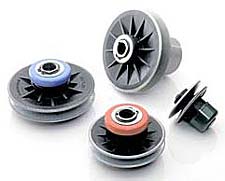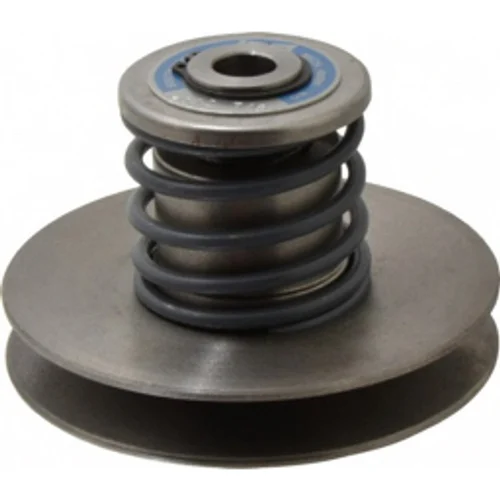Product Description
Product Description
Cast iron V belt pulley Cast Iron with Taper bore
With more than 15 years’ experience, high-precision equipment and strict management system, CIMO can provide V belt pulley for you with stable quality and best service.
V belt pulley specifications:
| V-Belt Pulley Type | Light Duty Bored to size Pulleys (AK,BK,2AK,2BK,3BK series) |
| Light Duty Taper Bore Pulleys (AK-H,BK-H,2AK-H,2BK-H series) | |
| Split taper bushed Pulleys (1TB,2TB,3TB series) | |
| Heavy Duty QD Pulleys (1B,2B,3B,1C,2C,3C,4C,5C series etc) | |
| Light Duty Variable Speed Pulleys (1VP,2VP,1VL,1VM series) | |
| QD taper bore sheaves Pulleys (3V,5V,8V series) | |
| Single Groove Pulleys (OK,OL,AL series) | |
| According to customers’ requirements or drawings | |
| Materials | Cast iron, steel, aluminium ,alloy, ect. |
| Surface treatment | powder coating, zinc plating, black oxided,etc |
| Standard | ANSI.API.BS.DIN.JIS.GB.etc. |
| Machine equipment | CNC center, CNC milling machine,CNC turning machine, CNC drilling |
| machine, CNC lathes, lathe, 4 axis machine etc. | |
| Application field | Equipment accessories, Airplane, Ship, Bicycle, Motorcycle, Auto, Medical,Chemical, Wheel, Sports, Anchor, Weapon, etc. |
| Certification | ISO9001:2015 |
| Warranty | One year after shippment |
| QC | 1. Materials are to be checked carefully before production. |
| 2.Strict processing quality control | |
| 3.100% inspection before shipment. | |
| Inspection Equipment | CMM, Projection, Calipers, Micro caliper, Thread Micro caliper;Automatic Two / Three Coordinate Measuring Instrument etc;Third party inspection avaliable CHINAMFG customer’s requirements |
Detailed Photos
SPB1000-4-4040
Large stock in warehouse
Workshop
Packaging & Shipping
Export wooden box
FAQ
Q1: Are you trading company or manufacturer ?
A: We are factory.
Q2: How long is your delivery time and shipment?
1.Sample Lead-times: 10-20 days
2.Production Lead-times: 30-45 days after order confirmed.
Q3: What is your advantages?
1. The most competitive price and good quality.
2. Perfect technical engineers give you the best support.
3. OEM is available.
| Certification: | ISO |
|---|---|
| Manufacturing Process: | Casting |
| Material: | Iron |
| Surface Treatment: | Phosphated |
| Application: | Chemical Industry, Grain Transport, Mining Transport, Power Plant |
| Material Code: | Cast Iron Gg25 |
| Customization: |
Available
| Customized Request |
|---|

What safety considerations should be kept in mind when working with variable pulleys?
When working with variable pulleys, it is important to keep several safety considerations in mind to ensure the well-being of individuals and prevent accidents. Here are some key safety considerations:
- Proper training: Only trained and authorized personnel should operate or work with variable pulleys. They should have a thorough understanding of the equipment, its functions, and the associated hazards. Training should cover topics such as proper usage, maintenance, and emergency procedures.
- Equipment inspection: Before using variable pulleys, it is crucial to inspect them for any signs of damage or wear. Check for issues such as frayed cables, loose bolts, or misalignment. If any defects are found, the pulleys should be taken out of service until repairs or replacements are made.
- Personal protective equipment (PPE): Workers should wear appropriate PPE, such as safety goggles, gloves, and protective clothing, to prevent injuries from flying debris, pinch points, or accidental contact with moving parts.
- Secure footing: Ensure that the work area around the variable pulleys is clean, well-lit, and free from any obstructions. Maintain good footing and position yourself in a stable manner to avoid slips, trips, and falls.
- Guarding: Install appropriate guards or barriers around the pulleys to prevent accidental contact with moving parts. This can include safety covers or enclosures that restrict access to the pulleys during operation.
- Lockout/tagout: Implement lockout/tagout procedures to control hazardous energy sources when performing maintenance or repairs on variable pulleys. This ensures that the equipment is properly shut down, isolated, and cannot be unintentionally started.
- Weight capacity: Always adhere to the weight capacity limits specified by the manufacturer. Overloading the pulleys can lead to equipment failure, loss of control, or structural damage.
- Proper use: Follow the manufacturer’s instructions and guidelines for the appropriate use of variable pulleys. Avoid using them for tasks or loads they are not designed for, as this can pose safety risks.
- Regular maintenance: Perform routine inspections, cleaning, and maintenance of the variable pulleys as recommended by the manufacturer. This helps identify potential issues early on and ensures the equipment operates safely and efficiently.
- Emergency preparedness: Have emergency procedures in place, including knowledge of emergency stops, shutdown procedures, and how to respond to accidents or malfunctions involving variable pulleys. Workers should be aware of evacuation routes and have access to communication devices for summoning help if needed.

What maintenance procedures are necessary to ensure the reliability of variable pulleys?
To ensure the reliability and longevity of variable pulleys, regular maintenance procedures should be followed. These maintenance procedures help prevent premature wear, ensure optimal performance, and extend the lifespan of the pulleys. Here are some essential maintenance procedures for variable pulleys:
1. Cleaning and Inspection:
Regular cleaning of variable pulleys is crucial to remove dirt, dust, and debris that can accumulate on the pulley surfaces. The pulleys should be inspected for any signs of wear, damage, or misalignment. If any issues are detected, appropriate actions, such as repairs or replacement, should be taken to prevent further damage.
2. Lubrication:
Proper lubrication is essential for smooth operation and reduced friction in variable pulleys. Lubricants should be applied to the pulley bearings, shafts, and other moving parts as recommended by the manufacturer. This helps minimize wear and ensures efficient power transmission.
3. Belt Tension Adjustment:
The tension of the belts or chains used with variable pulleys should be regularly checked and adjusted if necessary. Proper belt tension ensures optimal grip and power transmission efficiency. If the belts are too loose or too tight, it can lead to slippage, reduced performance, and increased wear on the pulleys and belts.
4. Alignment:
Variable pulleys should be properly aligned with the input and output shafts of the machinery. Misalignment can cause uneven belt wear, increased vibration, and reduced power transmission efficiency. Regular inspection and adjustment of the pulley alignment can prevent these issues and ensure smooth operation.
5. Belt or Chain Replacement:
Over time, belts or chains used with variable pulleys may wear out and require replacement. It is important to monitor the condition of the belts or chains and replace them when signs of wear, cracking, or stretching are observed. This helps maintain optimal power transmission and prevents unexpected failures.
6. Regular Performance Testing:
Periodic performance testing of variable pulleys is recommended to ensure they are operating as intended. This can involve measuring speed ratios, torque transmission, and overall efficiency. Performance testing helps identify any deviations from the desired specifications and allows for timely corrective actions.
7. Following Manufacturer’s Guidelines:
It is crucial to follow the maintenance guidelines provided by the pulley manufacturer. These guidelines may include specific maintenance intervals, recommended lubricants, inspection procedures, and other important instructions. Adhering to the manufacturer’s guidelines ensures that the pulleys are maintained correctly and in accordance with their design specifications.
By following these maintenance procedures, variable pulleys can remain reliable and perform optimally throughout their lifespan. Regular cleaning, inspection, lubrication, belt tension adjustment, alignment checks, belt or chain replacement when necessary, regular performance testing, and adherence to manufacturer’s guidelines contribute to the overall reliability and longevity of variable pulleys.

What types of belts are typically employed with variable pulleys?
Variable pulleys, also known as variable speed pulleys or variable drive pulleys, are compatible with various types of belts. The choice of belt depends on factors such as the specific application, power transmission requirements, and environmental conditions. Here are some types of belts commonly employed with variable pulleys:
1. V-Belts:
V-belts are one of the most common types of belts used with variable pulleys. They have a trapezoidal cross-section and are designed to fit into V-shaped grooves on the pulley halves. V-belts are known for their high friction grip, which allows for efficient power transmission. They can handle moderate to high-speed ratios and are suitable for applications requiring reliable power transfer.
2. Flat Belts:
Flat belts have a rectangular cross-section and are widely used with variable pulleys. They offer flexibility and are capable of transmitting high power loads. Flat belts typically have fabric or rubber coatings on both sides to enhance grip and prevent slippage. They are commonly used in applications where a wide speed range and high torque transmission are required.
3. Timing Belts:
Timing belts, also known as synchronous belts, are toothed belts that mesh with corresponding teeth on the pulley halves. They provide precise power transmission and are often used in applications where accurate timing and synchronization are critical. Timing belts are commonly employed in automotive engines, robotics, and other precision machinery.
4. Poly-V Belts:
Poly-V belts, also called multi-rib belts, have multiple V-shaped ribs on the inner surface. They are designed to fit into corresponding grooves on the pulleys. Poly-V belts offer high power transmission capabilities and are suitable for applications that require compact designs and high-speed ratios. They are commonly used in automotive accessory drives, such as alternator and power steering systems.
5. Round Belts:
Round belts, as the name suggests, have a circular cross-section and are commonly made of rubber or urethane materials. They provide flexibility and are often used in applications that require minimal vibration and noise. Round belts are suitable for light to moderate power transmission and are commonly used in applications such as office equipment, textile machinery, and small appliances.
It’s important to note that the selection of the appropriate belt for a variable pulley should consider factors such as load requirements, speed range, temperature constraints, and environmental conditions. Consulting the manufacturer’s specifications and recommendations can help ensure the optimal belt choice for a given application.


editor by CX
2023-10-16
